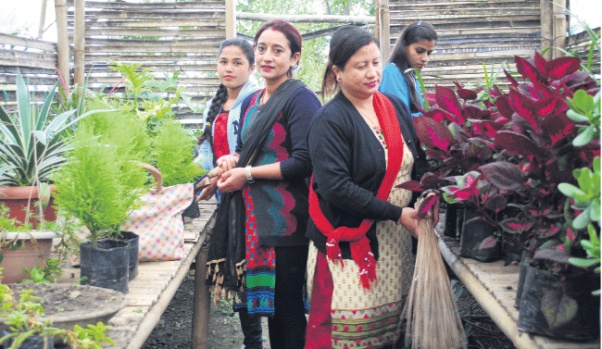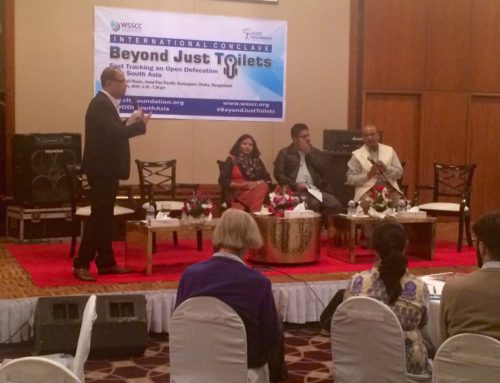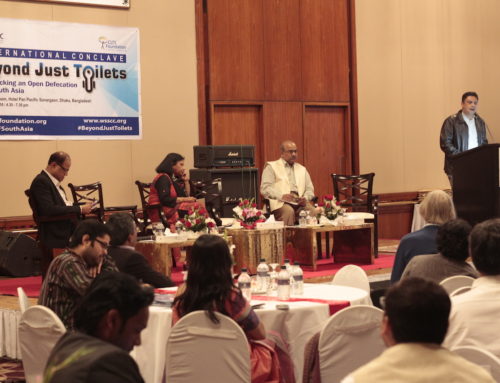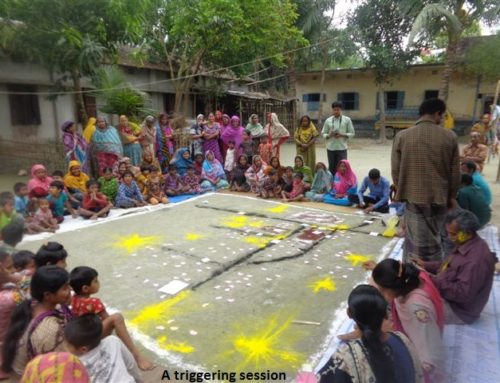Exemplary public participation sets Ilam as an example in sanitation

Nirjana Sharma/Republica Social and environmental activists associated with the Green City Women’s Group, Ilam tend to plants in the organization’s nursery maintained at Ilam Bazar in this recent picture. The Group supplies tree and flower saplings from this nursery for plantation across the town.
ILAM, Jan 9: When Devi Bhattarai, 37, takes a round of Ilam Bazar on her two-wheeler, the shopkeepers go on high alert. Some of them even get red with fear of being questioned by her, if she spots any dirt in their shops premises. Devi’s observation is not limited to the premises of the shop. She forces her way into the interior of the shop and even at times inspects status of the toilets. If she finds that the toilets are unclean or if water is not available inside, there is no way for the shopkeeper to getaway without facing her brunt.
“Devi helps us take responsibility of keeping the town clean and tidy. She has made us realize that we can keep the town only if we give importance to the minor things that go unnoticed most of the time,” says Kamana Bajracharya, 41, who runs a cosmetic shop in Tudikhel of Ilam Bazar.
Devi is one of a group member of Green City Women’s Group formed with an aim to develop the Ilam as the cleanest and the most environment-friendly district across the country. Devi is one of the many activists active in the district who have contributed in making Ilam a successful town in terms of total sanitation- including the availability of drinking water, toilet facilities and waste management among others. Along with that a weekly routine mandates compulsory involvement of locals, security personals, business owners, among others, in taking up their brooms and cleaning up the streets and tea gardens.
The locals have taken up the responsibility to maintain the sanitation status since the district was declared Open Defecation Free (ODF) in February last year, says the district-based senior journalist and social activist Dharma Gautam.
Gautam recalls the measures the government adopted to make people build the toilet. For the poor villagers, subsidies were given to build the toilet. But those who did not have one despite of their economic viability were barred from the government’s service such as citizenship card, birth certificate and passport. This steps sensitized people on sanitation issues, informs Gautam.
The district which had 64 percent of the toilet coverage as recorded in the National Census in 2011, hit the 100 percent target by the end of 2014 through massive participation of locals in the sanitation campaign.
Environment officer at the Ilam Municipality Office, Kamal Mainali says that the local’s activeness in the development has helped to cope with challenges that the office would have to struggle to manage like any other hilly districts of Nepal. Drinking water availability is one of the examples.
“When the drinking water crisis mounted in the town, locals not only pressurized the government to bring new drinking water projects but also actively participated in preserving tap water and conserving water resources which had already dried up,” said Mainali.
Scores of examples across the town, where locals contribute both money and labor to revive the dried up water resources, corroborate his claims. Four of the public taps in the town have already been restored through public efforts whereas restoration of another two is in the pipeline.
“Water taps are our property that serve hundreds of people in a week,” says Nanuka Khatri, 36, of Kuldhara, who works voluntarily to improve water and sanitation in the municipality, while expressing her commitment towards preserving public properties in the locality.
After achieving its sanitation goals, presently Ilam is moving towards establishing itself as a Green City. “Once the municipality starts dumping the waste segregating the biodegradable from the non-biodegradable, we only have the responsibility to maintain the achievements,” says Bhupal Raj Khatiwada, social mobilizer at the Namsaling Community Development Center, while expressing satisfaction over the public participation in the development of the town.
Ilam is ahead of the rest of the districts in terms of sanitation and environment friendliness. It is already polythene-bag free while only 31 out of the total 75 districts have gained the status of open defecation free districts. Other districts are struggling to complete their sanitation goals within timeframe set by the government.
At a time when the government missed national target of achieving 80 percent sanitation coverage by 2015, achieving 100 percent sanitation among all households would be a far-fetched dream if the locals had hesitated from actively participating in the sanitation plan, says Bal Krishna Pokhrel, a water, sanitation and hygiene expert at the Federation of Drinking Water and Sanitation Users Nepal (FEDWASUN).
“The national progress rate is fluctuating though the WASH master plan gives a clear road map for speeding up the water and sanitation campaign,” said Pokhrel. Sanitation coverage has been achieved among 70 percent of the total nation population, leaving out the remaining 30 percent prone to sanitation induced diseases and risks.
By Nirjana Sharma.
This article was first published at My Republica. It was part of a media advocacy partnership between WSSCC, Geneva and CLTS Foundation.





Leave A Comment